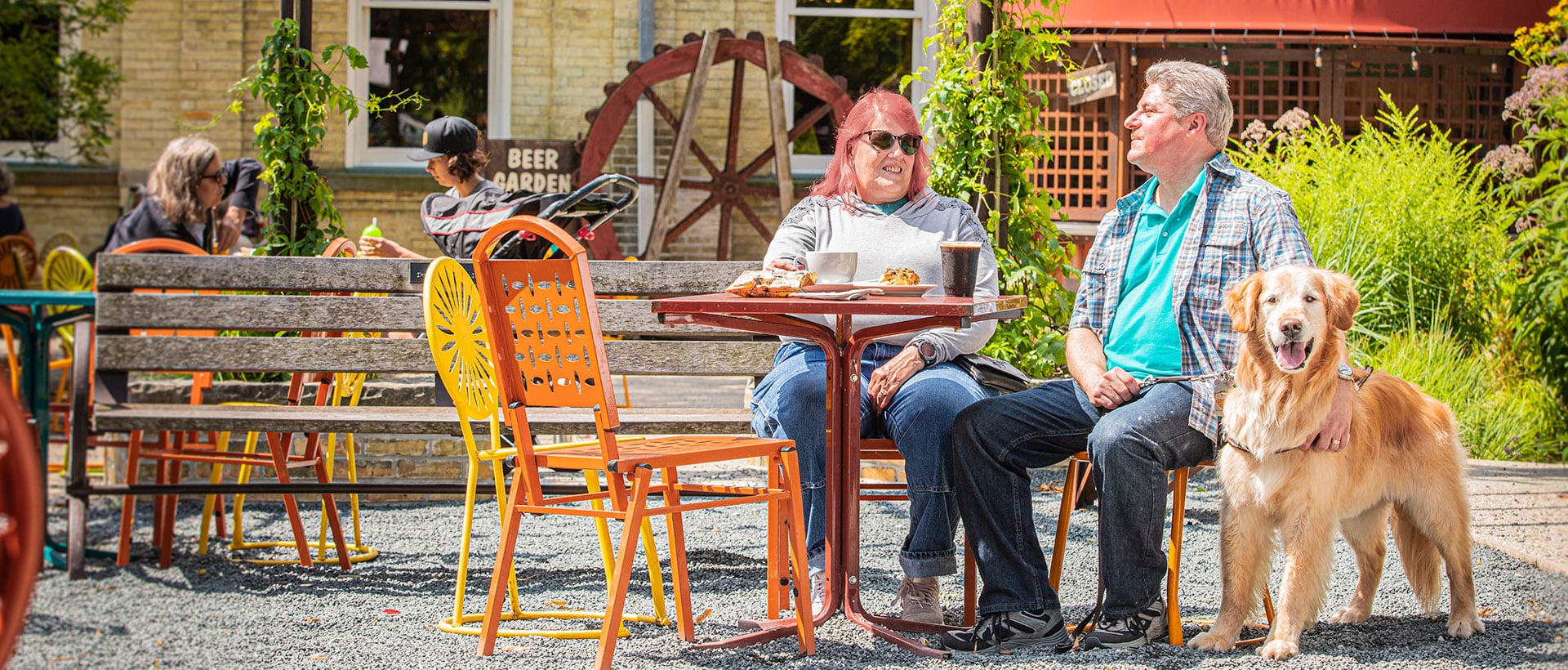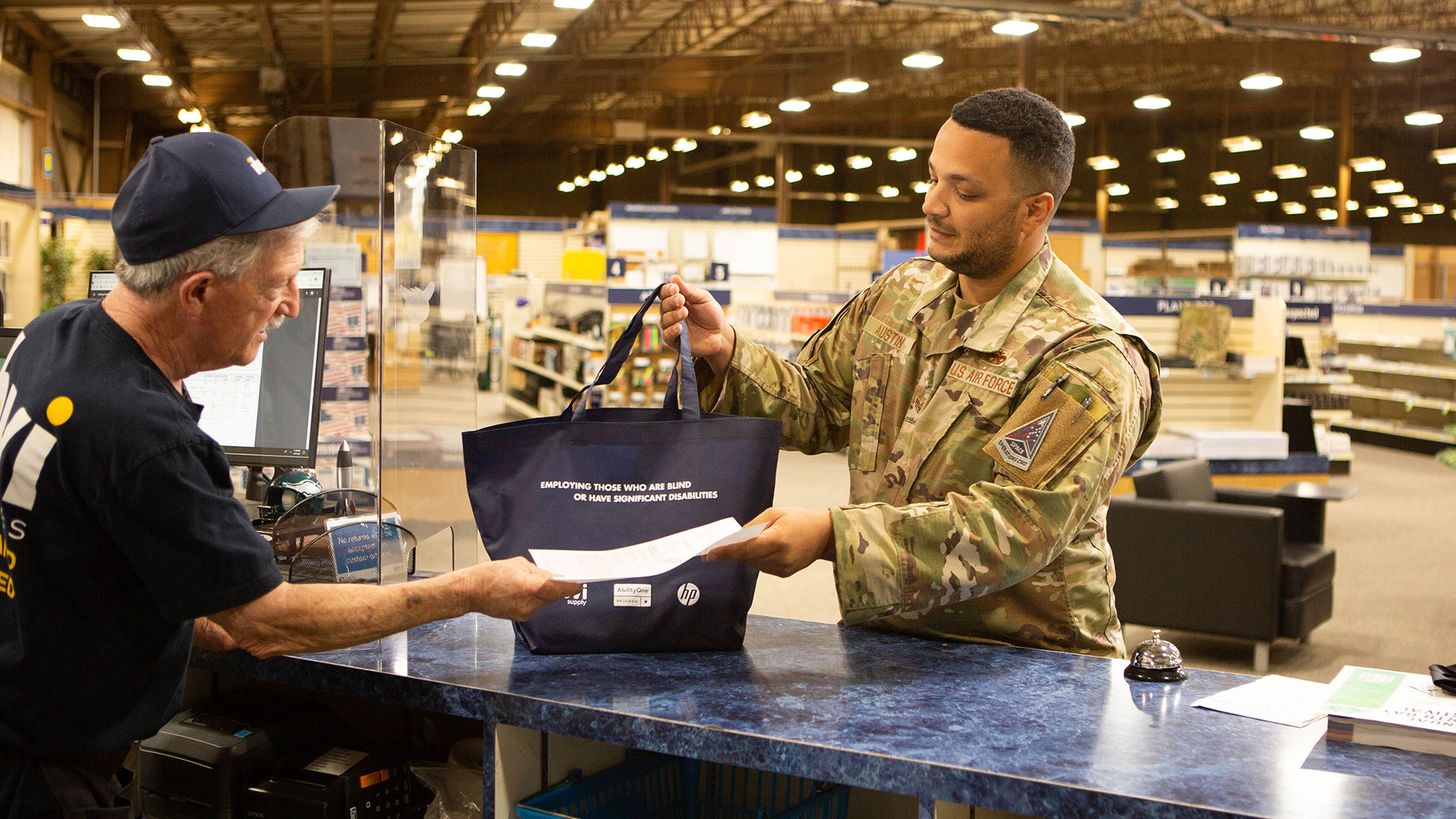Many sighted people are filled with a variety of questions about service dogs. Some of the most common questions we hear range from the obvious (“is it OK to pet your guide dog?”) to the fairly intense (“are guide dogs put to sleep after they retire?”). Since September is National Service Dog Month, we’ve decided it’s the perfect time to share everything you’ve ever wanted to know about guide dogs: how they’re trained, what they do, and yes – what happens when they retire.
What are service dogs?
To start, let’s talk about what service dogs are and how they work. Guide dogs help the blind and visually impaired navigate the world around them. These special pups go through rigorous training (as do their owners!) at special schools, which you’ll learn about shortly.
In addition to guide dogs for the blind, there are several other types of service dogs. Each service dog is rigorously trained to accommodate those with certain disabilities.

Hearing Dogs: Hearing dogs for people who are deaf are trained to alert their handlers to noises in the surrounding environment. If the doorbell rings, for example, they will make physical contact or turn in the general direction of where the sound is coming from to raise awareness.
Mobility Assistance Dogs: Mobility assistance dogs aid those struggling with mobility or balance – those with muscular dystrophy, for example. These amazing pups can retrieve dropped items, open and close doors, and even pull wheelchairs if needed.

Medical Detection Dogs: Medical assistance detection dogs have the amazing ability to identify the odor changes associated with life-threatening medical events and are paired with individuals who suffer from conditions ranging from epilepsy to diabetes. These talented pups are also used by law enforcement.

Heeling Autism Dogs: Heeling Autism dogs serve as companions and guardians for children with Autism, providing them with increased levels of independence and helping to provide confidence.

VetDogs : Programs like VetDogs are doing an amazing job of pairing in-need veterans with trained assistance dogs. Military Facility Dogs have become an important part of the rehabilitation process in many military and VA hospitals, offering emotional support to servicemen and women dealing with combat stress, home front issues and sleep disorders. For those that have already returned home, PTSD Service Dogs can help mitigate the effects of the condition and provide any emotional and physical support needed. These special dogs can be specifically trained to provide a sense of calm, alert someone for help or perform nightmare interruption.

In addition to these highly-trained service dogs, other types of emotional support dogs are also becoming quite common. These friendly, supportive pups can do anything from providing support to those suffering from anxiety, to bringing joy to hospitals or assisted living facilities. In recent years, some airports have even launched airport therapy dog programs during the holidays in order to help reduce anxiety among passengers.
Further Reading: Learn About The Five Different Type of Service Dogs
How are guide dogs trained?
Only a small percentage of dogs have the skills and traits needed to become a guide dog. Golden Retrievers, Labrador Retrievers or German Shepherds are the most popular choice for guide dogs for the blind, as these breeds tend to be quite intelligent, obedient and friendly. In addition to these three traits, guide dogs must also show attention to their surroundings, have the ability to concentrate in noisy or hectic environments, and show a willingness to learn.
Guide dogs for the blind are raised and trained by special schools like The Seeing Eye. Many of these schools are non-profit organizations that generously provide both their dogs and training support at little to no cost to anyone who qualifies.
For roughly the first year of their lives, prospective guide dogs live with highly trained “puppy raisers” who ensure each dog is well-cared for, socialized and able to adhere to basic commands. When they’re ready (typically at around 14 months old), the dog will return to the guide dog school to begin formal training. At this point in the process, only about 50% of dogs make the cut. If the pup exhibits signs of aggression, nervousness or reacts negatively to other animals, he’ll be carefully placed into a loving home instead.
Official guide dog training lasts roughly four months. Like traditional obedience training, guide dogs are trained on a reward system that encourages good behavior. During training, these smart pups will learn how to:
- Lead their handler in a straight line from point A to point B
- Stop for stairs or curbs
- Navigate obstacles both in their path and overhead
- Assess potential dangers before crossing a street
As you can imagine, it takes a very special dog to be able to pick up all of these skills! According to Guiding Eyes for the Blind, only 72% of dogs that passed the first cut into the training program will graduate the program and earn the official title of “guide dog”. This means that only around 32 out of every 100 dogs will make it through the entire guide dog training process. The other 78% will be placed with families. Because these dogs are so highly-trained compared to the average family pet, most schools have a very long waiting list of loving families who are eager to adopt these “disqualified” pups!
Further Reading: What it Takes to Be a Guide Dog
How are guide dogs matched with people?
As you may have guessed, in order to be placed with a guide dog, applicants must undergo an intense screening process. Each school has its own set of requirements, however, most require that the prospective “handler” (owner) prove both medical necessity and ability to properly handle and care for their new pup. While filling out their application, the prospective handler will answer questions about their environment and lifestyle, allowing them to be matched with the best guide dog for their needs.
Once a guide dog team has been matched, handlers will fly out to the school to meet their new guide dog and embark on an intensive 3-to-4 week training program. If the handler hasn’t worked with a guide dog before, they will go through a four week training program, whereas returning handlers will participate in a slightly shorter program each time they get a new guide dog. The ultimate goal of this training program is to help the handler and guide dog get acquainted, as well as teach them how to master the techniques needed for navigating daily life with a guide dog once they return home. During the training process, handlers also learn about proper feeding, canine massage, and everything else they need to know to help their guide dogs lead happy and healthy lives.
Further Reading: Training at The Seeing Eye: Meeting My New Guide Dog
What’s the difference between using a cane and using a guide dog?
Making the decision to use a cane or a guide dog is largely based on personal preference. Here at ibMilwaukee, some of our employees prefer to have their guide dogs accompany them to work, others prefer to use a cane, while some even switch between both! That being said, there are a few key benefits to using a guide dog.
While a cane can help detect obstacles, guide dogs are trained to proactively keep their handlers out of harm’s way. For example, if their handler is attempting to cross the street and is unaware there’s a car coming, the guide dog will stop and wait until it’s safe to cross. Guide dogs are also trained in something called “clearance work”. Not only will they safely lead their owners around any potential obstacles, but if they see something like a low hanging branch that might hit their owner in the face, they will alert their handler by slowing down. Guide dogs are also extremely helpful travel companions, helping their handlers make their way through airport security, navigate an airport, get settled at their hotel and even navigate through a busy city.
Further Reading: Who Let The Dogs In?
Is it OK to pet a guide dog?
This is a very common question, and the short answer is “no”. We completely understand that it can be difficult to resist the temptation of petting a sweet dog! However, it’s important to remember that when a guide dog is wearing his harness, this means that he is hard at work and you should not attempt to get his attention, pet him or give him a treat. Distracting a working service dog creates the same dangers that grabbing the steering wheel away from a driver would. Additionally, it’s important to keep your pets on a leash and close to you when crossing paths with a service dog. Even the best-trained service dog may be tempted to engage with other animals, and again, distracting a guide dog can be dangerous to his handler.
Finally, it’s important to be respectful of the relationship between guide dog and handler. Don’t interfere when a guide dog’s handler is giving a correction. While corrections may seem abrupt and may appear to startle a guide dog, rest assured that the handler has been professionally trained in giving corrections and they would never do anything to hurt their beloved dog.
Further Reading: The Do’s and Don’ts of Guide Dog Interaction
Why are fake service dogs an issue?
Service dogs are an incredibly important source of safety and independence for those who rely on them. Unfortunately, the issue of individuals passing their pets off as service animals is becoming more and more common. In some cases, people are even buying fake IDs, certifications and vests with legitimate-looking insignias for their pets to get them onto flights without paying a pet fee or into stores or restaurants where non-service animals are banned.
Needless to say, the issue of fake service animals is a frustrating problem for both the disabled community and business owners alike. Even if a customer is obviously attempting to get a family pet into an establishment under false pretenses, many businesses are hesitant to turn them away for fear of potentially discriminating against someone with legitimate disabilities. Still, many disabled individuals with legitimate service animals have unjustly been refused service – particularly by airlines, where it’s common for passengers to try to pass their pets off as a service dog in order to avoid paying a pet fee.
How can you spot a fake service dog? Legitimate service dogs and their handlers undergo rigorous training and receive certification to operate effectively (and quietly!) as a team no matter what environment they are in. Trained service dogs are virtually invisible and are solely focused on guiding and leading their handler. On the contrary, fake service dogs might bark or yelp, scratch, jump or beg. This post on Anything Pawsable has some great information for business owners on how to deal with the issue of fake service animals.
It’s important to remember that under the Americans with Disabilities Act, it’s a federal crime to use a fake service animal. Likewise, most states have laws against service animal misrepresentation.
Further Reading: Fake Service Animals: A Growing Problem with an Unclear Answer
When is a guide dog retired?
Generally speaking, most guide dogs will work until they’re roughly ten years old. Of course, much of this depends on the dog and his health. Choosing to retire a guide dog is a difficult decision, and one that is never taken lightly. Ultimately, service dogs are usually retired for a few reasons. While health issues and old age are the most common reasons, there are instances where a dog may be retired at a relatively young age due to training issues. For cases like these, schools like The Seeing Eye will send a trainer out to see if the issues can be remedied through re-training. If not, the handler may choose to retire their dog, as was the case with one employee’s beloved guide dog, Valla.
One of the most common things people wonder is what happens when a guide dog retires. There’s a common – and unfortunate – misconception that retired guide dogs are put to sleep, but that couldn’t be further from the truth! Some handlers choose to keep their retired guide dogs as family pets, while others may opt to return their dog to the school they received him from. The school will then match the retired dog with a loving family. In fact, retired guide dogs are so popular that many families stay on a waitlist for up to four years before getting the chance to adopt!
Further Reading: When a Guide Dog Retires, What’s Next?
Guide dogs provide their handlers with independence, increased mobility, safety, support – and of course, friendship. It’s apparently clear that the relationship between a guide dog and his handler is very special – perhaps even more so than the traditional dog-owner bond. In fact, a few years ago, the relationship between our National Sales Director Dan Bailey and his guide dog (and reliable travel companion) Phelps even inspired an uplifting New York Times editorial!
If you’re interested in learning even more about guide dogs, both The Seeing Eye and Guide Dogs for the Blind have a wide variety of information available on their websites for both prospective guide dog owners as well as those who simply wish to educate themselves on the topic.
ibMilwaukee is a guide dog friendly employer!
As a company dedicated to providing meaningful employment opportunities for blind and visually impaired professionals, ibMilwaukee is proud to be a guide dog-friendly workplace. We currently have a wide range of employment opportunities available both in our Milwaukee office and around the United States, and relocation assistance is available! Learn about our warm and welcoming company culture and currently available employment opportunities: www.ibmilwaukee.com/joinus.



